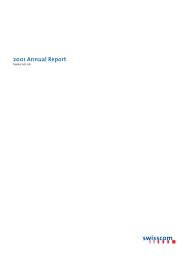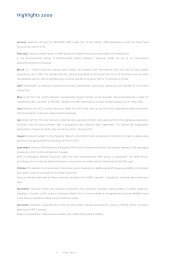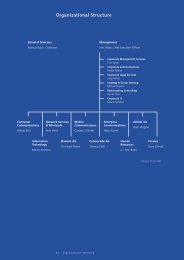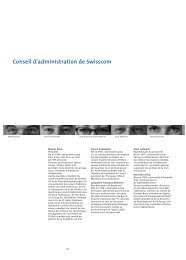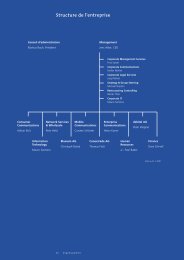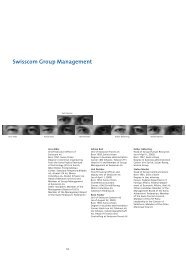Notes to the consolidated financial statements - Swisscom
Notes to the consolidated financial statements - Swisscom
Notes to the consolidated financial statements - Swisscom
You also want an ePaper? Increase the reach of your titles
YUMPU automatically turns print PDFs into web optimized ePapers that Google loves.
Principles of consolidation<br />
The <strong>consolidated</strong> <strong>financial</strong> <strong>statements</strong> of <strong>Swisscom</strong> include <strong>the</strong> operations of <strong>Swisscom</strong> AG<br />
and all its direct and indirect subsidiaries which <strong>Swisscom</strong> AG controls by more than 50%<br />
of <strong>the</strong> votes.<br />
Investments and joint ventures where <strong>Swisscom</strong> exercises significant influence but does<br />
not have control are accounted for using <strong>the</strong> equity method. Under <strong>the</strong> equity method,<br />
investments are disclosed as investments in affiliated companies and presented at <strong>the</strong>ir<br />
fair value as of <strong>the</strong> date of acquisition adjusted for <strong>Swisscom</strong>’s share in earnings (losses)<br />
resulting after <strong>the</strong> date of acquisition.<br />
A schedule with all significant subsidiaries and investments in affiliated companies is presented<br />
in Note 41.<br />
Subsidiaries and investments acquired or disposed of during <strong>the</strong> year are included in <strong>the</strong><br />
<strong>consolidated</strong> <strong>financial</strong> <strong>statements</strong> from <strong>the</strong> date of acqui-sition and excluded from <strong>the</strong><br />
date of sale respectively.<br />
All intercompany balances, transactions and intercompany profits are eliminated on consolidation.<br />
Significant balances and transactions with investments and joint ventures accounted for<br />
using <strong>the</strong> equity method are separately disclosed as items with affiliated companies.<br />
Goodwill and o<strong>the</strong>r intangible assets<br />
Goodwill<br />
Differences between <strong>the</strong> purchase price of acquisitions and <strong>the</strong> fair value of net assets acquired<br />
are classified as goodwill from acquisitions. Goodwill is amortized on a straightline<br />
basis over <strong>the</strong>ir estimated useful life of 5 <strong>to</strong>10 years.<br />
Research and development<br />
Research and development expenditure is recognized as an expense as incurred.<br />
Software development costs<br />
Generally, costs associated with developing or maintaining computer software programs<br />
are recognized as an expense as incurred. However, costs that are directly associated with<br />
identifiable and unique software products controlled by <strong>Swisscom</strong> and have probable future<br />
economic benefits are recognized as intangible assets and amortized using <strong>the</strong><br />
straight-line method over <strong>the</strong>ir estimated useful life of 3 years. Expenditure which enhances<br />
or extends <strong>the</strong> performance of computer software programs beyond <strong>the</strong>ir original<br />
specifications is recognized as a capital improvement and added <strong>to</strong> <strong>the</strong> original cost of <strong>the</strong><br />
software.<br />
O<strong>the</strong>r intangible assets<br />
O<strong>the</strong>r intangible assets, which comprise primarily mobile license fees are capitalized at<br />
cost and amortized using <strong>the</strong> straight-line method over <strong>the</strong> life of <strong>the</strong> license, starting<br />
when <strong>the</strong> network becomes operational. See Note 25.<br />
Impairment of intangible assets<br />
If <strong>the</strong>re is an indication that <strong>the</strong> carrying value of an intangible asset, including goodwill,<br />
may be impaired, <strong>Swisscom</strong> determines <strong>the</strong> estimated recoverable amount. If <strong>the</strong> recoverable<br />
amount of <strong>the</strong> asset is less than its carrying amount, <strong>the</strong> carrying amount is reduced<br />
<strong>to</strong> <strong>the</strong> recoverable amount, with <strong>the</strong> difference representing an impairment charge.<br />
Foreign currency translation<br />
Foreign currency transactions are accounted for at <strong>the</strong> exchange rates prevailing at <strong>the</strong><br />
date of <strong>the</strong> transactions; gains and losses resulting from <strong>the</strong> settlement of such transactions<br />
and from <strong>the</strong> translation of monetary assets and liabilities denominated in foreign<br />
currencies, are recognised in <strong>the</strong> income statement, except when deferred in equity as<br />
qualifying cash flow hedges.<br />
Assets and liabilities of subsidiaries and affiliated companies accounted for using <strong>the</strong> equity<br />
method reporting in currencies o<strong>the</strong>r than Swiss francs are translated at <strong>the</strong> rates of exchange<br />
prevailing at balance sheet date. Goodwill and fair value adjustments arising on<br />
<strong>the</strong> acquisition of foreign entities are treated as assets of <strong>the</strong> foreign entity and translated<br />
at <strong>the</strong> rate prevailing at balance sheet date. Income, expenses and cash flows are translated<br />
at <strong>the</strong> average exchange rates for <strong>the</strong> period. Translation gains and losses are<br />
21 <strong>Swisscom</strong> Consolidated <strong>financial</strong> <strong>statements</strong>







